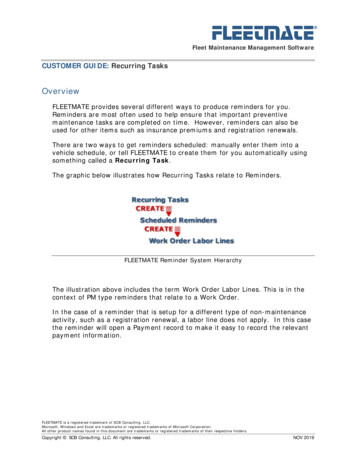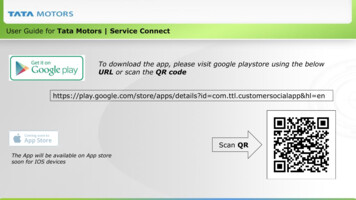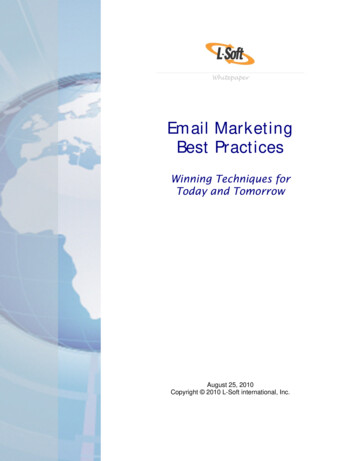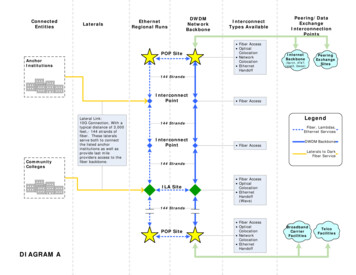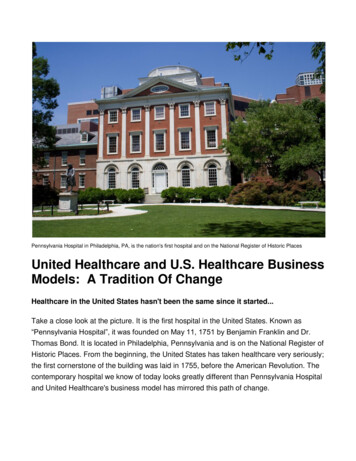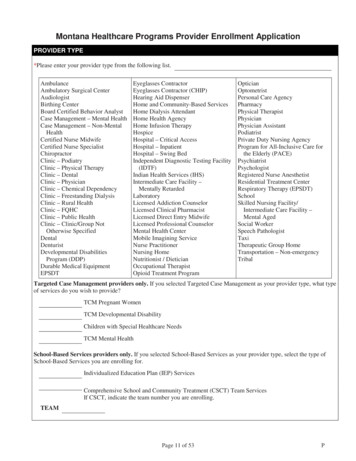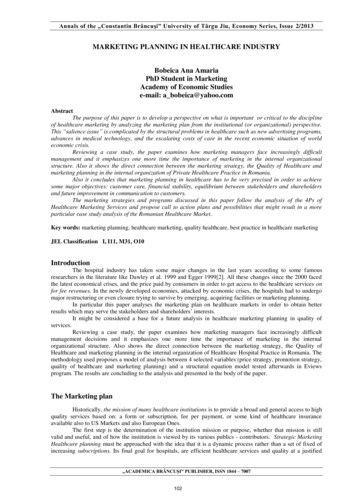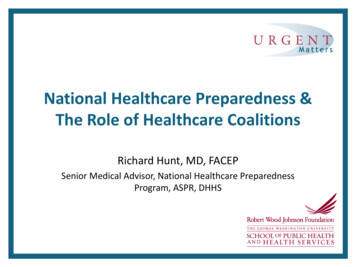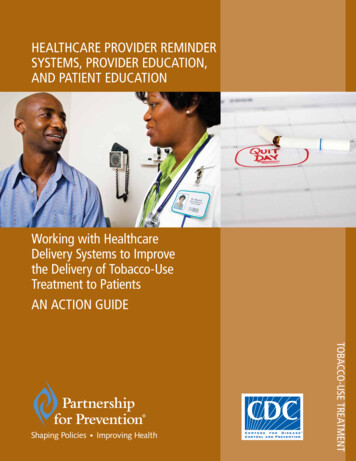
Transcription
HEALTHCARE PROVIDER REMINDERSYSTEMS, PROVIDER EDUCATION,AND PATIENT EDUCATIONWorking with HealthcareDelivery Systems to Improvethe Delivery of Tobacco-UseTreatment to PatientsAn Action GuideTobacco-use treatment
This publication was developed and produced with funding fromthe Centers for Disease Control and Prevention (CDC) under cooperative agreementU58CCU322077. Its contents are solely the responsibility of the authors and do not necessarilyrepresent the official views of the Centers for Disease Control and Prevention.Centers for Disease Control and PreventionNational Center for Chronic Disease Prevention and Health PromotionDivision of Adult and Community HealthSteps Program4770 Buford Highway, NE, Mailstop K-93Atlanta, GA 30341PHONE: 770.488.5269 FAX: 770.488.5964 E-MAIL: nccdodsteps@cdc.govhttp://www.cdc.gov/stepsThis publication and the other titles in The Community Health Promotion Handbook are availableon the Internet to download or order at http://www.prevent.org/actionguides. Diabetes ManagementDiabetes Self-Management Education (DSME): Establishing a Community-Based DSME Programfor Adults with Type 2 Diabetes to Improve Glycemic Control —An Action Guide Physical ActivityPlaces for Physical Activity: Facilitating Development of a Community Trail and PromotingIts Use to Increase Physical Activity Among Youth and Adults—An Action Guide School-Based Physical Education: Working with Schools to Increase Physical Activity AmongChildren and Adolescents in Physical Education Classes—An Action GuideSocial Support for Physical Activity: Establishing a Community-Based Walking Group Programto Increase Physical Activity Among Youth and Adults—An Action GuideTobacco-Use TreatmentHealthcare Provider Reminder Systems, Provider Education, and Patient Education: Workingwith Healthcare Delivery Systems to Improve the Delivery of Tobacco-Use Treatment to Patients—An Action GuideSuggested citationPartnership for Prevention. Healthcare Provider Reminder Systems, Provider Education, andPatient Education: Working with Healthcare Delivery Systems to Improve the Delivery of TobaccoUse Treatment to Patients—An Action Guide. The Community Health Promotion Handbook: ActionGuides to Improve Community Health. Washington, DC: Partnership for Prevention; 2008.April 2008(Updated April 2009)
HEALTHCARE PROVIDER REMINDER SYSTEMS,PROVIDER EDUCATION, ANDPATIENT EDUCATIONWorking With Healthcare Delivery Systemsto Improve the Delivery of Tobacco-UseTreatment to PatientsAn Action GuidePartnership for Prevention is a nonprofit organization dedicated to preventing illness and injuryand promoting health. Partnership’s programs reach policy makers, a wide range of public healthand healthcare professionals, businesses, and others who can emphasize prevention.Partnership for Prevention 1015 18th Street, NW, Suite 300Washington, DC 20036PHONE: 202.833.0009 FAX: 202.833.0113http://www.prevent.org
Project Advisory CommitteePartnership for Prevention expresses sincere appreciation to the members of its Project AdvisoryCommittee for their expert guidance in developing The Community Health Promotion Handbookand for their ongoing support of the organization. The Committee’s time and expertise contributedsignificantly to the vision and content of this publication.Georges C. Benjamin, MD, FACP, ChairExecutive DirectorAmerican Public Health AssociationThe Honorable Roderick L. BrembySecretaryKansas Department of Health and EnvironmentNed Calonge, MD, MPHChief Medical OfficerColorado Department of Public Health andEnvironmentLarry Cohen, MSWExecutive DirectorPrevention InstituteJonathan E. Fielding, MD, MPH, MBADirector and Health OfficerLos Angeles County Department of Public HealthPaul K. Halverson, DrPH, MHSADirector and State Health OfficerArkansas Department of HealthTom Kean, MPHExecutive DirectorC-ChangeMichelle Kegler, DrPH, MPHDeputy DirectorEmory Prevention Research CenterAssociate ProfessorRollins School of Public HealthEmory UniversityAmy Friedman Milanovich, MPHDeputy DirectorAllies Against AsthmaCenter for Managing Chronic DiseaseUniversity of MichiganMarcus Plescia, MD, MPHChiefChronic Disease and Injury SectionNorth Carolina Division of Public HealthStephanie Zaza, MD, MPHCaptain, U.S. Public Health ServiceStrategy and Innovation OfficerCoordinating Center for Terrorism Preparedness andEmergency ResponseSteps Program Director (2003–2006)National Center for Chronic Disease Prevention andHealth PromotionCenters for Disease Control and PreventionContributorsPartnership for Prevention recognizes the following individuals who contributed extensive knowledgeand expertise as key informants and reviewers of Healthcare Provider Reminder Systems, ProviderEducation, and Patient Education: Working with Healthcare Delivery Systems to Improve the Deliveryof Tobacco-Use Treatment to Patients—An Action Guide, one of five action guides that make up TheCommunity Health Promotion Handbook.Rob Adsit, MEdManager of Education and Outreach ProgramsCenter for Tobacco Research and InterventionSchool of Medicine and Public HealthUniversity of WisconsiniiTobacco-Use Treatment in Healthcare Delivery SystemsErica Barrett, MOT, MBAThe Ginn GroupSteps ProgramDivision of Adult and Community HealthNational Center for Chronic Disease Preventionand Health PromotionCenters for Disease Control and Prevention
Wendy Bjornson, MPHDirectorTobacco Cessation Leadership NetworkCo-DirectorSmoking Cessation CenterOregon Health & Science UniversityDavid P. Hopkins, MD, MPHCoordinating Scientist (Chief Medical Officer)Community Guide BranchDivision of Health Communication and MarketingNational Center for Health MarketingCenters for Disease Control and PreventionPeter A. Briss, MD, MPHCaptain, U.S. Public Health ServiceScience OfficerCoordinating Center for Environmental Health andInjury PreventionCommunity Guide Branch Director (2003-2006)National Center for Health MarketingCenters for Disease Control and PreventionCorinne G. Husten, MD, MPHEpidemiology Branch ChiefOffice on Smoking and HealthNational Center for Chronic Disease Preventionand Health PromotionCenters for Disease Control and PreventionStuart J. Cohen, EdDProfessor of Public Health and Medicine (retired)Mel & Enid Zuckerman College of Public HealthUniversity of ArizonaSusan J. Curry, PhDProfessorHealth Policy and AdministrationSchool of Public HealthDirectorInstitute for Health Research and PolicyUniversity of Illinois at ChicagoSallie Dacey, MDFormer Co-ChairTobacco Expert TeamGroup Health Cooperative of Puget SoundAlyssa Easton, PhD, MPHSteps Program DirectorDivision of Adult and Community HealthNational Center for Chronic Disease Preventionand Health PromotionCenters for Disease Control and PreventionMichael C. Fiore, MD, MPHProfessor of MedicineDirectorCenter for Tobacco Research and InterventionSchool of Medicine and Public HealthUniversity of WisconsinTracy IngrahamNorthrop Grumman CorporationSteps ProgramDivision of Adult and Community HealthNational Center for Chronic Disease Preventionand Health PromotionCenters for Disease Control and PreventionThomas E. Kottke, MD, MSPHConsulting CardiologistHealthPartners Medical GroupSenior Clinical InvestigatorHealthPartners Research FoundationProfessor of MedicineUniversity of MinnesotaTim McAfee, MD, MPHChief Medical OfficerSenior Vice President, Clinical and Behavioral SciencesFree & Clear, Inc.Lezli A. Redmond, MPHDirector of Education and Outreach ProgramsCenter for Tobacco Research and InterventionSchool of Medicine and Public HealthUniversity of WisconsinAbby C. Rosenthal, MPHBusiness Strategic CoordinatorOffice on Smoking and HealthNational Center for Chronic Disease Preventionand Health PromotionCenters for Disease Control and PreventionJack F. Hollis, PhDSenior InvestigatorKaiser Permanente Center for Health ResearchTobacco-Use Treatment in Healthcare Delivery Systemsiii
Scott E. Sherman, MD, MPHStaff PhysicianVA New York Harbor Healthcare SystemAssociate Professor of MedicineNew York University School of MedicineC. Barr Taylor, MDProfessor of Psychiatry and MedicineSchool of MedicineStanford UniversityLeif I. Solberg, MDAssociate Medical DirectorHealthPartners Medical GroupDirectorHealthPartners Research FoundationAcknowledgmentsPrincipal authors from Partnership for Prevention are Mamta Gakhar, MPH; Alyson Hazen, MPH;Hema Khanchandani, MPH, MA; and Amy Stitcher, MPH.Partnership for Prevention would like to thank Stephanie Jacks; Michelle Marzullo, MA; andMolly Rauch, MPH, for providing research support and thoughtful feedback throughout developmentof The Community Health Promotion Handbook.Robert Harmon, MD, MPH, and Susan K. Maloney, MHS, served as advisors to this project.Special thanks to EEI Communications for editorial and production support.Partnership for Prevention is especially grateful for the funding support from the Centers for DiseaseControl and Prevention and extends thanks to experts from the National Center for Chronic DiseasePrevention and Health Promotion and the Community Guide Branch, National Center for HealthMarketing, who participated in the development and technical review of The Community HealthPromotion Handbook.ivTobacco-Use Treatment in Healthcare Delivery Systems
Table of ContentsIntroduction 1Section 1: Overview of the Approach 3Section 2: Implementing the Approach 6Getting StartedAction Step 1—Conduct a preliminary assessment to understand the currentenvironment surrounding tobacco-use treatment in healthcare deliverysystems in your community. 8Action Step 2—Begin organizing the human, material, and financial resources thatyou will need to perform your initiative’s outreach activities and to providesupport services to a healthcare delivery system. 9Action Step 3—Identify the healthcare delivery system you will encourage toimplement this tobacco-use treatment strategy, and develop a tailoredoutreach campaign. (Depending on your objectives, you may choose toengage more than one system at the same time.) 9Action Step 4—Engage the targeted healthcare delivery system’s existing partnersand key stakeholders by educating them about your initiative’s strategy forimproving the delivery of evidence-based tobacco-use treatment. 12Action Step 5—Once the targeted healthcare delivery system is committed to yourinitiative, identify which of its departments will be responsible for movingthe strategy forward. 15Action Step 6—Have the identified department spearhead the formation of aninternal working group within the healthcare delivery system to guideimplementation of this tobacco-use treatment strategy and to beginplanning for the evaluation component. 16Action Step 7—Understand and inform the internal working group’s goals forimplementing this tobacco-use treatment strategy, assist in addressingpossible billing and coding issues, and reach agreement with the groupabout which needed support services will be provided by you or others. 17Moving ForwardAction Step 8—Encourage the internal working group to agree on the use of theevidence-based 5A’s model as the standard of practice for delivering a brieftobacco-use intervention. 21Action Step 9—Assist the internal working group in developing the healthcareprovider reminder system, which involves using the first component—“ask”—of the 5A’s model to identify the tobacco-use status of every patient and thenprompting clinicians to intervene on the basis of the tobacco-use status. 23Action Step 10—Support the internal working group in mapping out the other fourcomponents of the 5A’s model—“advise,” “assess,” “assist,” and “arrange”—and related patient education. 24Action Step 11—Encourage the internal working group to agree on evidence-basedstandards of practice for delivering an intensive tobacco-use intervention. 26Action Step 12—Assist the internal working group in identifying key objectives ofhealthcare provider education in order to acquire and adapt appropriatetraining resources and determine ongoing training needs. 29Action Step 13—Collaborate with the internal working group to review and refineproject evaluation activities. 31Action Step 14—Assist the internal working group with the rollout of the selectedpolicies, processes, and practices for this tobacco-use treatment strategy. 32Tobacco-Use Treatment in Healthcare Delivery Systemsv
Table of ContentsLooking BeyondAction Step 15—Publicize the success of your initiative’s outreach campaignand the healthcare delivery system’s implementation of this tobacco-usetreatment strategy. 32Action Step 16—Continue to promote internal working group activities andbuild relationships with healthcare delivery administrators and staff asyou work on sustainability and expansion of your initiative. 33Action Step 17—Encourage the healthcare delivery system’s stakeholders tosupport other public health and policy interventions that increasetobacco-use cessation. 33Appendix A: Determining Your Resource Needs 36Appendix B: Evaluating Your Activities 40Appendix C: References and Resources 43Appendix D: Glossary of Selected Terms 52Feedback Form 53viTobacco-Use Treatment in Healthcare Delivery Systems
IntroductionThe Community Health Promotion Handbook: Action Guides to Improve Community Health is animportant tool, composed of five Action Guides, that translates evidence-based recommendations intothe necessary “how to” guidance for implementation of effective community-level health promotionstrategies. Although The Community Health Promotion Handbook is designed primarily to assist publichealth practitioners in implementing evidence-based practices, additional audiences who may benefitfrom using this resource include local planners, advocates, policy makers, community and businessleaders, community-based organizations, educators, healthcare providers, and others interested inimproving health in their communities.The Community Health Promotion Handbook was developed through a collaborative effort betweenPartnership for Prevention —a national membership organization dedicated to building evidence ofsound disease prevention and health promotion policies and practices and advocating their adoptionby public and private sectors—and the Centers for Disease Control and Prevention (CDC). Theseimplementation guidelines have emerged from the experiences of the 40 communities supported byCDC’s Steps Program, which is creating models for how local communities can act to address chronicdiseases. The Steps Program’s current focus areas are obesity, diabetes, and asthma, as well as the relatedrisk factors of physical inactivity, poor nutrition, and tobacco use.All five Action Guides are based on specific health promotion recommendations from The Guideto Community Preventive Services (Community Guide), which is published by the Task Force onCommunity Preventive Services. This independent decision-making body makes recommendations forthe use of various public health interventions on the basis of the evidence of effectiveness gathered in therigorous and systematic scientific reviews of published studies. Although these recommendations adviseon “what to do,” they do not provide the guidance needed to successfully take the interventions “fromthe page to the field.” Partnership for Prevention and CDC have worked together to bridge this gapbetween research and practice by developing The Community Health Promotion Handbook.This Action Guide focuses on a specific approachfor implementation of its related Community Guiderecommendation. When selecting among effectiveinterventions to improve health outcomes, you shouldfirst assess your resources and health priorities. After thisup-front analysis is completed and this approach is deemedappropriate and viable for your community’s needs, thisAction Guide can be used to facilitate your activities.The information within this Action Guide is intended tobe generalizable to a range of communities, but you willneed to determine what modifications may be necessaryto meet your local health objectives. Rather than aprescriptive list of required actions, general steps andsuggestions are provided in this guide to accommodatethe unique aspects of communities and their resources.This Action Guide should be used along with technicalassistance offered by experienced organizations, local orstate health experts, public health program managers,researchers, or others with relevant expertise.Tobacco-Use Treatment in Healthcare Delivery Systems1
IntroductionInformation in this Action Guide is organized under the following sections and appendixes: Section 1: Overview of the ApproachThis section provides information on the Community Guide’s recommendation and the supportingevidence, presents the specific approach used in this Action Guide, describes expected outcomesfrom implementing the approach, and suggests a role for the reader that both is feasible andmaximizes the ability to effect change. Section 2: Implementing the ApproachThis section of the Action Guide provides the bulk of implementation guidance by addressingthe “who,” “what,” “when,” “where,” and “how” of the activities. Key stakeholders you may wantto engage are listed within this section, as well as their related interests and potential roles aspartners. Action steps are laid out to follow a general progression, from Getting Started to MovingForward to Looking Beyond. Although the action steps are numbered to suggest an order of activityyou might consider, in practice, many steps will likely occur simultaneously or may occur in asequence different from what appears in this Action Guide. Appendix A: Determining Your Resource NeedsPersonnel, material, and financial resources that may be needed to successfully plan, implement,and sustain the approach are suggested here. You must determine what resources are necessary,ways to obtain those resources, and their costs. In the personnel resources subsection, a tablepresents a summary of tasks to allocate or assign among the main individuals and groups involved.The material and financial resources subsections each contain a list of items to consider based onthe activities described in this Action Guide. Appendix B: Evaluating Your ActivitiesEvaluation is a crucial component of public health practice and should begin to be addressedduring the planning stage. Although it is outside the scope of this Action Guide to provide specificguidance on how to conduct an evaluation, this appendix does provide questions to help youcollect data for process and outcome evaluations. Potential sources of data relevant to the approachare also included. Appendix C: References and ResourcesHere you will find a list—by topic—of references used in the development of this Action Guide andresources that provide information on similar approaches; tools for planning, implementation, andevaluation; and general guidance. Appendix D: Glossary of Selected TermsWords that are listed in this appendix are italicized in the guide’s text whenever they are used inorder to alert you that a definition is provided.2Tobacco-Use Treatment in Healthcare Delivery Systems
Section 1Overview of the ApproachThe EvidencePromoting the widespread prevention and treatment of tobacco use is a primary goal in improvingpublic health. Treating current users and preventing new users is the only way to eliminate the disease,death, and healthcare costs from this preventable epidemic. In terms of efficacy, cost effectiveness,and health impact, “tobacco-use screening and brief intervention (providing brief counseling andoffering medication)” is ranked as one of the top three clinical preventive services (Maciosek et al.,2006). Research has shown that healthcare delivery systems that want to improve their delivery ofevidence-based tobacco-use treatment should focus on systems strategies. One evidence-based systemsstrategy for increasing the number of people who stop using tobacco is to implement a multicomponentintervention made up of healthcare provider reminder systems, provider education, and patienteducation. This strategy’s primary focus is to have healthcare providers identify tobacco-using patientsand both increase the frequency and improve the effectiveness of their treatment. This strategy canbe used in various healthcare delivery systems (i.e., a network of healthcare professionals and facilitiesorganized to deliver patient care, such as private practices, managed care organizations, hospitals, andpublic health clinics) and can involve a variety of healthcare provider specialties such as primary care,cardiology, pulmonology, surgery, obstetrics, and dentistry.The Task Force on Community Preventive Services (TFCPS) recommends that an intervention that iscomposed of educating and prompting healthcare providers to identify and to intervene with tobaccousing patients (as well as to provide supplementary educational materials to patients when appropriate)be implemented to increase the number of tobacco users who quit. This recommendation is based onstrong evidence of effectiveness found through a systematic review of published studies conductedby a team of experts on behalf of the TFCPS. Information on their recommendation, published inThe Guide to Community Preventive Services: What Works to Promote Health? (Community Guide), ispresented in Table 1 on page 5. Related publications by the TFCPS and reviews by other organizationsare listed under “Evidence-Based Reviews of Interventions to Treat Tobacco Use and Decrease Exposureto Secondhand Smoke” in Appendix C: References and Resources. The three components of TFCPS’srecommendation are Healthcare provider reminder system—A system that identifies patients who use tobacco andreminds clinicians to advise these patients against tobacco use at every visit. Individuals from theclinical or office staff manage the system, and clinicians are reminded through the use of medicalchart stickers, medical record flowsheets, or checklists. A reminder system can also work byexpanding the vital signs profile to include tobacco use. With electronic medical record systems,automated versions of these methods have been created.Healthcare provider education—Training to improve the knowledge and skills of cliniciansin delivering evidence-based brief or intensive tobacco-use treatment, including tobacco-usescreening, behavioral counseling, and medication. Brief tobacco-use treatment consists ofscreening all adult patients and parents of pediatric patients for tobacco use, providing less thanthree minutes of brief behavioral counseling for those who use tobacco, and offering medicationto assist in quitting. With intensive tobacco-use treatment, more time is devoted to counselingpatients to quit using tobacco, and treatment is delivered by an appropriately trained clinicianthrough individual, group, or telephone-based counseling. In healthcare provider education,clinicians should also be informed of community referral resources, such as quitlines, that offerintensive treatment that can supplement clinicians’ efforts. Healthcare provider education can bepresented in a variety of ways, including written materials, videos, lectures, academic detailing inclinical settings, and continuing medical education seminars. It is also appropriate for the officestaff to receive education on related administrative responsibilities.Patient education—Information provided by clinicians that educates and motivates patientswho use tobacco to quit and remain abstinent. Self-help materials are a common form of patienteducation, but should be used in conjunction with other treatment components.Tobacco-Use Treatment in Healthcare Delivery Systems3
Section 1—Overview of the ApproachThe ApproachThis Action Guide focuses on assisting local public health practitioners in increasing cessation ratesamong tobacco users through the following approach: working with healthcare delivery systems toimprove the delivery of tobacco-use treatment—in both inpatient and outpatient settings—throughhealthcare provider reminder systems, provider education, and patient education. Although theCommunity Guide’s recommendation in Table 1 states “with or without patient education,” it should benoted that this Action Guide’s approach incorporates all three tobacco-use treatment components—provider reminder systems, provider education, and patient education—into its steps and information.Specific decisions relating to patient education materials should be made by clinicians to reflectavailable resources and the individual needs of each patient.On the basis of an assessment of their resources and community’s needs, public health practitionerscommitted to increasing tobacco-use cessation in their community may find the approach outlinedin this Action Guide to be appropriate and viable. Implementing this tobacco-use treatment strategyrequires the participation of the healthcare delivery system’s clinical staff (i.e., health professionals whodirectly provide healthcare services to patients), which is made up of primary or specialty care providers(e.g., physicians, physician assistants, nurse practitioners) and many other types of health professionals(e.g., nurses, pharmacists, medical assistants, health educators, psychologists, therapists). Office staff(e.g., individuals working at the front desk, in medical records, or in information technology) will alsobe involved in an administrative capacity.The three components of this tobacco-use treatment strategy are specifically addressed in Action Step9 (developing a healthcare provider reminder system), Action Step 10 (providing patient educationmaterials), and Action Step 12 (developing and conducting healthcare provider education).Expected OutcomesCommunities that successfully engage healthcare delivery systems to implement healthcare providerreminder systems, provider education, and patient education can expect to see the following results: Healthcare delivery systems will institute systems changes to improve the delivery of evidencebased tobacco-use treatment.These changes will inform, motivate, and prompt clinicians to assist patients in quitting tobaccouse.Clinicians in turn will deliver evidence-based tobacco-use treatment (counseling and medication)to an increased number of patients who use tobacco.More patients who use tobacco will attempt to quit.More patients who attempt to quit using tobacco will succeed in quitting for good, therebydecreasing the risks for coronary heart disease, lung and other cancers, chronic obstructivepulmonary disease, and other tobacco-related diseases.Implementing this approach can be useful in addressing tobacco-related objectives of the nationalHealthy People 2010 initiative, such as 1) increasing the proportion of physicians and dentists whocounsel their at-risk patients about tobacco-use cessation and 2) reducing tobacco use by adults.Your RoleAs a public health practitioner, your role in working with healthcare delivery systems to implementhealthcare provider reminder systems, provider education, and patient education will depend on theneeds of your healthcare community and the resources and capacity you have to conduct an outreachcampaign and facilitate the implementation of these enhancements. Healthcare delivery systemsmay lack the knowledge on how to best implement this approach; therefore, one option for you toconsider is to coordinate the outreach campaign and assist, as needed, with planning, implementing,4Tobacco-Use Treatment in Healthcare Delivery Systems
Section 1—Overview of the Approachand evaluating this tobacco-use treatment strategy within the healthcare delivery system. The role ofinitiative coordinator is the focus of this Action Guide.Table 1: Highlights of Community Guide‘s RecommendationRecommendationHealthcare Provider Reminder Systems with Provider Education, with or without PatientEducation—Strong Evidence of EffectivenessFindingsThese multicomponent interventions to increase tobacco-use cessation include efforts to educateand to prompt providers to identify and to intervene with tobacco-using patients, as well as toprovide supplementary educati
Larry Cohen, MSW Executive Director Prevention Institute Jonathan E. Fielding, MD, MPH, MBA Director and Health Officer Los Angeles County Department of Public Health Paul K. Halverson, DrPH, MHSA Director and State Health Officer Arkansas Department of Health Tom Kean, MPH Executive Director C-Change Michelle Kegler, DrPH, MPH Deputy Director
